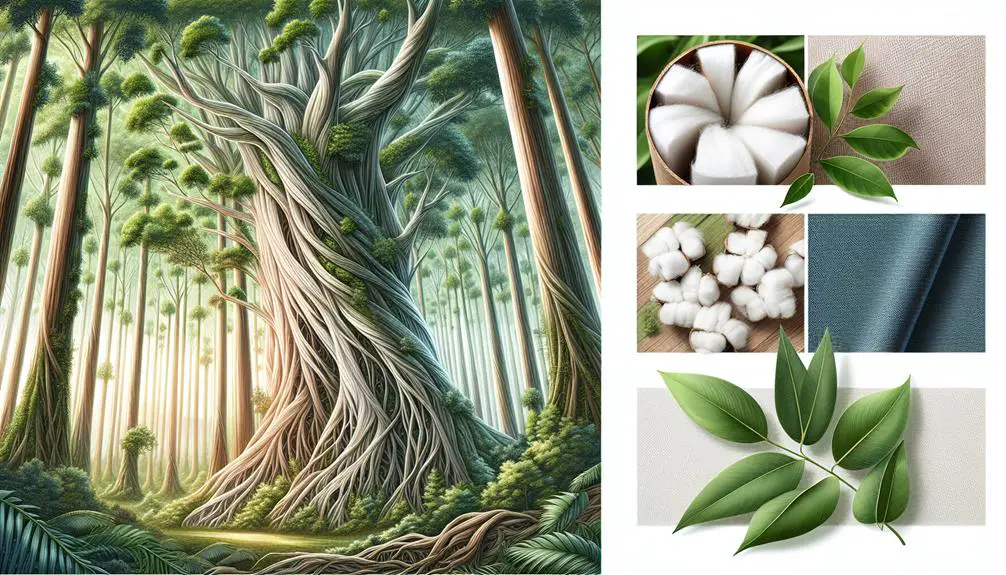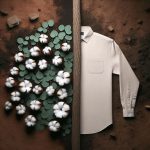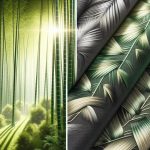I've found that Tencel Lyocell is pretty similar to a few fabrics. It compares to cotton mainly because they're both breathable and great for everyday use. It's also similar to bamboo, sharing eco-friendly traits and moisture-wicking properties. Plus, it feels luxurious like silk, thanks to its smooth texture and elegant drape. Tencel even mimics linen with its resistance to wrinkles and softness. Basically, it's like a hybrid of the best features of several natural fibers but steps up with sustainability. Curious to know how this impacts your wardrobe choices? Stick around, and I'll spill more details.
Table of Contents
Key Takeaways
- Tencel Lyocell is similar to cotton in breathability, moisture absorption, and suitability for daily wear.
- Its texture and luxurious feel are comparable to silk.
- Like bamboo fibers, Tencel is eco-friendly, biodegradable, and derived from renewable resources.
- Tencel shares linen's properties of smoothness, beautiful drape, and resistance to wrinkles.
- Its production process resembles that of Modal and Rayon, focusing on eco-friendly, closed-loop systems.
Origins of Tencel Lyocell
Tencel Lyocell comes from natural cellulose found in wood pulp, mainly sourced from eucalyptus trees. This origin story isn't just cool because it starts in a forest; it's crucial because it highlights the sustainable backbone of Tencel Lyocell production. Eucalyptus trees grow quickly and don't need much water or pesticides, which makes them a superstar in sustainable sourcing. Plus, they're farmed on non-arable land, so they don't compete with food crops.
The process that turns this wood into comfy textiles is equally impressive. It uses a closed-loop system, which means almost all the chemicals and water used to transform the wood pulp into fibers are recycled and reused. This system minimizes waste and reduces the environmental impact, setting a gold standard in eco-friendly material production.
Understanding these origins and processes is key for anyone keen on mastering the art of sustainable textiles. Tencel Lyocell isn't just about being eco-friendly; it's about pioneering practices that could redefine fabric production. It's a prime example of how innovative techniques can turn natural resources into something that's both useful and sustainable.
Similarities to Cotton
Let's talk about why Tencel Lyocell and cotton feel so good to wear.
Both materials are really breathable and absorb moisture well, which keeps you cool and dry.
This makes them perfect choices for everything from daily wear to activewear.
Breathability and Comfort
In terms of breathability and comfort, I find that Tencel Lyocell rivals cotton, making it a top choice for staying cool and comfortable in warmer climates. Both materials are celebrated for their soft and smooth texture, enhancing not just the look but the feel of garments.
With their lightweight nature, these fabrics don't weigh you down, making them ideal for everyday wear. The moisture-wicking properties of Tencel Lyocell are particularly impressive, helping to regulate body temperature by drawing sweat away from the skin. This feature, in combination with its excellent air circulation, ensures that you stay dry and comfortable throughout the day.
It's easy to see why Tencel Lyocell is a go-to for breathable, comfortable clothing.
Moisture Absorption Properties
Much like cotton, Tencel Lyocell excels in absorbing moisture, which enhances its breathability and comfort in clothing and bedding. Here's why it's such a hit:
- Efficient Absorption: Tencel Lyocell fibers are structured to pull moisture away from the skin, keeping you cool and dry.
- Superior to Polyester: It can absorb up to 50% more moisture than polyester, making it a top choice for those sweaty days.
- Ideal for Various Uses: Perfect for activewear, sleepwear, and even those breezy summer outfits.
- Soft and Comfortable: The moisture management of Tencel Lyocell contributes to its soft, comfortable feel against the skin.
- Breathable Features: Its ability to manage moisture enhances its breathability, ensuring comfort throughout the day.
Comparison With Silk
Now let's talk about how Tencel Lyocell stacks up against silk, focusing on texture and comfort, plus durability and maintenance.
I've noticed that while both materials are super soft, Tencel offers a robustness that silk can't match, making it easier to care for.
We'll see how Tencel isn't only comfy but also holds up better over time without the fuss.
Texture and Comfort
Tencel Lyocell feels just as luxurious and silky as silk, providing unbeatable comfort and a smooth touch. If you're keen on diving into what makes it so special, here's a quick rundown:
- Silk-like texture: It's so smooth and soft, you might confuse it with actual silk.
- Moisture-wicking properties: Keeps you dry and comfy, no matter the weather.
- Drapes beautifully: Adds an elegant flair to any outfit.
- Breathable quality: You'll stay cool and fresh all day.
- Gentle and soothing sensation: It's like a cozy hug for your skin.
Honestly, the comfort level is top-notch, making it a superb choice for anyone looking for luxury without the fuss.
Durability and Maintenance
Despite its luxurious feel, Tencel Lyocell is surprisingly more durable and easier to maintain than silk. It's machine washable, which simplifies my life immensely. I don't have to fuss with the delicate hand-washing or expensive dry cleaning required for silk.
This makes Tencel not only user-friendly but also more sustainable and eco-friendly. It's reassuring to know that the fabric's luxurious qualities don't compromise its durability. It holds up well against wear and tear, making it an excellent choice for everyday use.
Plus, just like silk, it's gentle on the skin, offering comfort without the high maintenance. So, I'm not sacrificing comfort for convenience, which is a win-win in my book.
Tencel and Bamboo Fibers
Exploring the world of sustainable textiles, I've found that both Tencel Lyocell and bamboo fibers stand out for their eco-friendly qualities. These materials aren't just good for the earth; they're also fantastic for anyone looking to improve their wardrobe's impact on the environment.
Here's why you might consider choosing these fabrics:
- Sustainability: Both fibers are derived from renewable resources. Tencel Lyocell comes from wood pulp, and bamboo fibers are harvested from bamboo plants.
- Eco-Friendly: They're biodegradable, breaking down naturally without harming the environment.
- Softness: Each offers a unique softness that enhances comfort, making them ideal for clothing and bedding.
- Moisture-Wicking: Their ability to wick moisture away from the skin makes them perfect for sportswear and summer clothing.
- Unique Properties: Bamboo is naturally antibacterial, and Tencel Lyocell has a luxurious drape that adds a smooth, silky feel to fabrics.
These attributes make Tencel Lyocell and bamboo fibers top choices for anyone seeking eco-friendly, sustainable, and high-performance textiles. Their softness and moisture-wicking abilities, combined with their biodegradable nature, highlight their superior qualities in the textile industry.
Linen Vs. Tencel Properties
While both linen and Tencel Lyocell are celebrated for their eco-friendly properties, they differ significantly in texture and production sustainability. Linen, derived from the flax plant, has a distinct, textured feel that's crisp to the touch. It's renowned for its breathability and moisture-wicking capabilities, making it a favorite for hot weather wear. However, it does tend to wrinkle easily, which can be a drawback for those seeking a sleek appearance without constant maintenance.
On the other hand, Tencel Lyocell, made from wood pulp, presents a smoother and silkier texture that drapes beautifully and resists wrinkles well. This fiber also excels in moisture management, similar to linen, which helps in keeping the skin dry and comfortable. While both materials offer these desirable properties, Tencel Lyocell steps ahead in terms of sustainability. Its production involves a closed-loop process, which recycles almost all chemicals and water used, making it a more sustainable choice over linen.
As someone deeply interested in the ecological aspects and practical benefits of fabrics, understanding these differences helps me make informed decisions about my wardrobe and recommend the best options to others looking for comfort and sustainability.
Environmental Impact
Tencel Lyocell's production significantly reduces environmental impact through its innovative closed-loop process. As someone deeply invested in sustainability, I'm always excited to share how eco-friendly and effective these processes are. Tencel Lyocell stands out as a prime example of environmental responsibility in textile manufacturing.
Here's why Tencel Lyocell is a game-changer in the fabric industry:
- Sustainable Bioenergy: The use of renewable bioenergy in its production minimizes carbon footprint.
- Non-toxic Solvent: It incorporates a non-toxic solvent that's safer for the environment compared to the harsh chemicals used in traditional fabric production.
- High Solvent Recovery Rate: Most of the solvent used during production is recovered and recycled, which drastically cuts waste.
- Zero Waste Production: The process is designed to produce no waste, ensuring that all materials are utilized efficiently.
- Lower Overall Environmental Impact: Compared to other fibers like modal and viscose, Tencel Lyocell has a significantly lower environmental footprint.
For anyone keen on mastering sustainable fashion, understanding the importance of materials like Tencel Lyocell is crucial. It's not just about wearing trends; it's about supporting processes that prioritize our planet's health.
Production Process Insights
I'll dive right into how the production process of Tencel Lyocell is carried out, focusing on its similarities with other fibers like Modal and Viscose.
Firstly, both Tencel Lyocell and Modal involve dissolving cellulose in a chemical solution to create their fibers. This step is crucial as it transforms tough plant material into a soft, versatile fabric.
Like Viscose, the spinning method used for Tencel Lyocell is quite similar. Both processes involve regenerating cellulose fibers into a usable textile form. What's fascinating here is how these fibers are spun into yarns, making the transition from a wood-based pulp to a soft, durable fiber.
Moreover, Tencel Lyocell shares a method with Rayon in extracting cellulose from plants. However, what truly sets Tencel Lyocell apart is its commitment to sustainable practices. The production process is designed as a closed-loop system, which means nearly all the chemicals and solvents used are recycled and reused. This not only minimizes waste but also significantly reduces environmental impact, aligning Tencel Lyocell closely with eco-friendly manufacturing principles. It's a brilliant example of how modern textiles can be both luxurious and gentle on our planet.
Durability and Maintenance
Let's explore how Tencel Lyocell's durability and easy maintenance make it a standout choice for both clothing and home products. I've always appreciated materials that don't demand too much fuss, and Tencel Lyocell fits the bill perfectly. It combines robustness and ease that can simplify daily routines.
Here's why Tencel Lyocell is such a treasure:
- Machine washable: Just toss it in the washer! It maintains its color and shape, which saves both time and energy.
- Resistant to wrinkles: This fabric doesn't require frequent ironing, making it ideal for those of us who are always on the go.
- Low maintenance: Its ability to look good with minimal care makes Tencel Lyocell a practical choice for busy lifestyles.
- Pilling resistance: You won't find those annoying little balls on your clothes or sheets after several uses.
- Stretching resistance: It holds its original form well, so you don't have to worry about your garments sagging out of shape.
With these features, Tencel Lyocell not only promises durability but also ensures that maintenance is a breeze. It's clear why this material shines in both performance and practicality.
Applications in Textiles
In exploring the applications of Tencel Lyocell in textiles, I'm struck by its incredible fabric quality and feel.
It's not just soft; it also has a real luxury vibe that makes it perfect for high-end fashion.
Plus, its environmental impact is minimal, which is great for those of us who are eco-conscious.
Fabric Quality and Feel
Tencel Lyocell's softness and luxurious feel make it a top choice for comfy clothing and cozy home textiles. The fabric quality is simply unmatched, blending comfort with a high-end touch. Here's why you'll love it:
- Softness: Feels incredibly gentle against the skin.
- Moisture-wicking properties: Keeps you dry by efficiently managing moisture.
- Elegant drape: Adds a graceful flow to dresses and curtains alike.
- Eco-friendly production: Supports sustainability without sacrificing quality.
- Durability: Stands up to wear and tear, making it a smart investment.
I've found that Tencel Lyocell's balance of style and practicality is unbeatable, especially if you're aiming for both comfort and a cleaner planet in your textile choices.
Environmental Impact
I've noticed that both Tencel Lyocell and Modal significantly lessen environmental impact when used in textiles. By deriving these fibers from natural cellulose sources, they inherently reduce the environmental footprint compared to synthetics. Not only do Tencel Lyocell and Modal require less water than traditional cotton, but their production processes are also largely toxin-free and meet the Oeko-Tex® certification standards. This makes them standout choices for eco-conscious fashion.
Moreover, both Tencel Lyocell and Modal are biodegradable and compostable. This feature ensures that when textiles made from these fibers reach the end of their life, they can be returned to nature without leaving harmful residues. It's a win-win for both style and sustainability.
Versatility in Fashion
Let's explore how Tencel Lyocell's versatility makes it a favorite in various fashion applications. Its unique properties and eco-friendly production align closely with today's sustainable fashion needs. Here's a quick look at why it stands out:
- Softness and Drape: Similar to modal, Tencel Lyocell offers a luxurious feel, making it perfect for elegant dresses and comfortable shirts.
- Moisture-Wicking: Ideal for activewear, thanks to its excellent moisture management.
- Luxurious Appearance: Shares a similarity with viscose, adding a touch of class to outfits.
- Versatile Applications: Like rayon, it's adaptable across various fashion items.
- Sustainable Choice: Its environmentally conscious production process makes it a go-to for eco-aware fashionistas.
Tencel Lyocell, with its broad appeal, truly meets the mark in the fashion world.
Consumer Recommendations
Many users recommend Tencel Lyocell for its comfort and eco-friendly qualities, noting its similarity to Modal in both texture and performance. If you're like me and always hunting for the next best thing in sustainable fashion or bedding, you'll want to give this fabric a try. Tencel Lyocell and Modal aren't just about feeling good; they perform incredibly well too. Both fabrics boast moisture-wicking properties that are a lifesaver for anyone who hates that sticky feeling on hot nights or during a workout.
When it comes to sustainability, these materials are top-notch. Both are produced by Lenzing AG with a keen focus on minimal environmental impact, making them a smart choice for those of us trying to make responsible consumer decisions. Whether it's clothing or bedding, opting for Tencel Lyocell means you're not just choosing quality and comfort, but also contributing to a healthier planet.
Personally, I've switched a lot of my wardrobe and linen closet to these fabrics. The luxurious feel combined with their eco-friendly credentials makes them hard to beat. If you're ready to up your game in sustainable living, Tencel Lyocell and Modal should definitely be on your radar.
Frequently Asked Questions
What Fabric Is Similar to Tencel?
Tencel's quite similar to Modal, Viscose, and Rayon. They're all soft, breathable, and derived from plant-based materials, making them great for eco-conscious clothing. I love how comfortable they feel!
Is Tencel Lyocell the Same as Polyester?
No, Tencel Lyocell isn't the same as polyester. It's derived from natural sources and is biodegradable, unlike synthetic, less eco-friendly polyester. It's also softer and more breathable, making it quite distinct.
Is Tencel Lyocell Like Cotton?
Yes, Tencel Lyocell is quite like cotton. It's soft, breathable, and wicks moisture well, making it comfy for hot weather. Plus, it's got a silky smooth feel, even softer than cotton!
What Does Tencel Lyocell Feel Like?
Tencel Lyocell feels incredibly soft and smooth, offering a luxurious, silk-like touch. It's also breathable and moisture-wicking, making it cool and comfortable for me to wear, especially in warmer weather.
- Choosing the Right Fabrics for Babies - July 20, 2024
- Impact of Fabrics on Skin Health - July 20, 2024
- Benefits of Antimicrobial Fabrics - July 20, 2024








